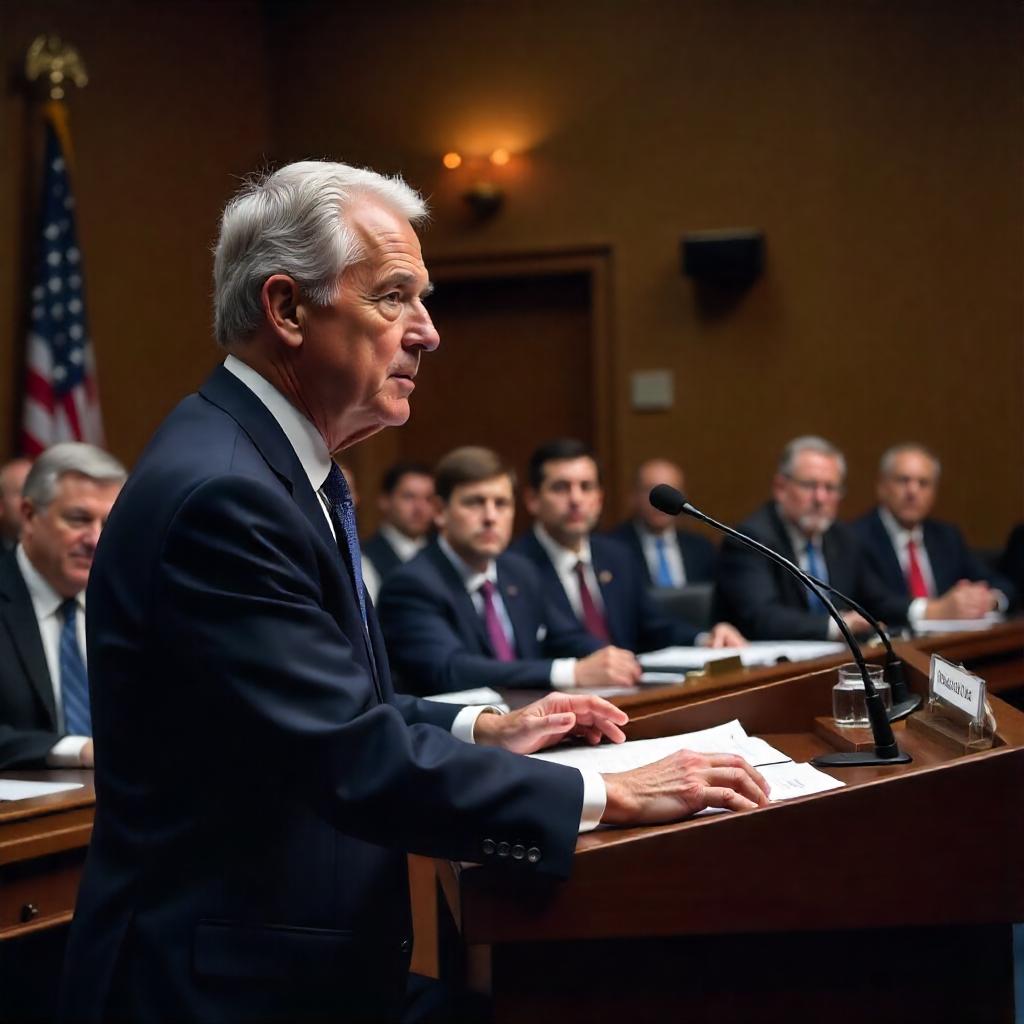The Federal Reserve’s June 2025 Policy Decision
On June 18, 2025, the U.S. Federal Reserve made a pivotal decision that reverberated across financial markets: it chose to maintain the federal funds rate within the 4.25% to 4.50% range. This move, while anticipated by many, set the stage for a series of market reactions and speculations, particularly within the cryptocurrency sector.
In the days leading up to the Fed’s announcement, global markets were already on edge. The introduction of the “Liberation Day” tariffs by President Donald Trump had sent shockwaves through international trade relations, leading to heightened inflation concerns and market volatility. Despite these pressures, the Fed’s decision to hold rates steady was a testament to its cautious approach in navigating the complex economic landscape.
Bitcoin, often seen as a barometer for investor sentiment in the crypto space, responded to the Fed’s decision with notable resilience. Trading at approximately $104,209 on the day of the announcement, Bitcoin demonstrated a steadying effect amidst the prevailing uncertainties. This stability was particularly significant given the backdrop of geopolitical tensions, such as the U.S. military actions in Iran, which had previously led to brief market dips.
The Fed’s stance was clear: while inflation remained a concern, the economic indicators did not yet warrant a change in monetary policy. Chair Jerome Powell emphasized the need for more data to assess the full impact of recent tariffs and other economic factors before making any adjustments to interest rates.
This decision underscored the Fed’s commitment to its dual mandate: fostering maximum employment and maintaining stable prices. By holding rates steady, the central bank aimed to provide a stable environment for economic growth, even as it acknowledged the challenges posed by external factors like trade policies and geopolitical events.
For Bitcoin and the broader cryptocurrency market, the Fed’s decision was a signal of continuity. It suggested that, despite the tumultuous macroeconomic environment, the underlying fundamentals of digital assets remained intact. Investors and market participants took this as an indication that the crypto market could continue its maturation process, with increasing institutional adoption and regulatory clarity providing a foundation for future growth.
In the subsequent sections, we will delve deeper into the Fed’s rationale behind its decision, the immediate market reactions, and the broader implications for the cryptocurrency landscape. Understanding these dynamics is crucial for investors and stakeholders aiming to navigate the evolving intersection of traditional finance and digital assets.
Bitcoin’s Market Response
In the wake of the Federal Reserve’s decision to maintain interest rates at 4.25% to 4.50% on June 18, 2025, Bitcoin’s market response was notably composed, reflecting a maturation in its role within the broader financial ecosystem.
On the day of the announcement, Bitcoin traded at approximately $104,364, marking a modest 0.43% increase over the previous 24 hours. This stability came despite the Fed’s revised economic projections, which anticipated slower GDP growth and persistent inflationary pressures. Analysts had widely expected the rate hold, with the CME FedWatch Tool indicating a near 100% probability of such an outcome.
This price stability suggests that Bitcoin is increasingly being viewed as a distinct asset class, less susceptible to the immediate fluctuations driven by traditional monetary policy decisions. The cryptocurrency’s resilience in the face of macroeconomic uncertainties underscores its evolving role as a store of value, akin to gold, particularly in periods of economic volatility.
In the broader context, Bitcoin’s performance was also influenced by geopolitical developments. For instance, the announcement of a ceasefire between Israel and Iran on June 23, 2025, alleviated some market anxieties, leading to a rally in U.S. equities. While Bitcoin’s response was more subdued, the overall market sentiment was positively impacted.
Furthermore, the establishment of the U.S. Strategic Bitcoin Reserve earlier in the year has bolstered investor confidence in Bitcoin. This initiative, aimed at positioning Bitcoin as a national reserve asset, highlights the growing institutional recognition of the cryptocurrency’s value proposition.
In summary, Bitcoin’s measured response to the Fed’s rate decision reflects its maturation as an asset class. While traditional financial markets may continue to exhibit volatility in reaction to central bank policies, Bitcoin’s evolving role suggests a shift towards a more stable and recognized position within the global financial system.
Factors Influencing Bitcoin’s Resilience
Bitcoin’s resilience in 2025 can be attributed to several key factors that have collectively enhanced its position in the global financial landscape. These factors include institutional adoption, regulatory clarity, and macroeconomic conditions.
Institutional Adoption
The involvement of institutional investors has significantly bolstered Bitcoin’s credibility and stability. Major financial institutions, including BlackRock and Fidelity, have launched Bitcoin exchange-traded funds (ETFs), attracting substantial investments. For instance, BlackRock’s Bitcoin ETF has seen inflows exceeding $600 million, reflecting growing institutional confidence in the asset. Additionally, corporations like MicroStrategy have increased their Bitcoin holdings, with the company acquiring over 11,000 BTC in early 2025. This trend indicates a shift from speculative investment to strategic asset allocation among institutional players.
Regulatory Clarity
Regulatory developments have played a crucial role in fostering a conducive environment for Bitcoin’s growth. In March 2025, U.S. President Donald Trump signed an executive order establishing a Strategic Bitcoin Reserve, positioning Bitcoin as a national reserve asset. This move has been complemented by favorable regulatory policies, including the appointment of pro-crypto officials to key positions, signaling a commitment to supporting the cryptocurrency sector. Such regulatory clarity has alleviated concerns among investors and institutions, encouraging further participation in the market.
Macroeconomic Conditions
Macroeconomic factors, such as inflation concerns and currency devaluation, have driven investors to seek alternative assets like Bitcoin. The cryptocurrency’s fixed supply and decentralized nature make it an attractive hedge against traditional financial system risks. Moreover, Bitcoin’s performance has shown a decoupling from traditional risk assets, with its price movements becoming less correlated with equities and fiat currencies. This behavior suggests that Bitcoin is increasingly viewed as a store of value, akin to gold, especially during periods of economic uncertainty.
In conclusion, Bitcoin’s resilience in 2025 is the result of a confluence of institutional adoption, regulatory support, and favorable macroeconomic conditions. These factors have collectively strengthened Bitcoin’s position as a legitimate and stable asset class, paving the way for its continued growth and integration into the global financial system.
Implications for Crypto Investors
Bitcoin’s resilience in 2025 is not merely a product of market speculation but is underpinned by several foundational factors that have collectively enhanced its stature in the global financial ecosystem.
Institutional Adoption
The increasing involvement of institutional investors has significantly bolstered Bitcoin’s credibility and stability. Major financial institutions, including BlackRock and Fidelity, have launched Bitcoin exchange-traded funds (ETFs), attracting substantial investments. For instance, BlackRock’s Bitcoin ETF has seen inflows exceeding $600 million, reflecting growing institutional confidence in the asset. Additionally, corporations like MicroStrategy have increased their Bitcoin holdings, with the company acquiring over 11,000 BTC in early 2025. This trend indicates a shift from speculative investment to strategic asset allocation among institutional players.
Regulatory Clarity
Regulatory developments have played a crucial role in fostering a conducive environment for Bitcoin’s growth. In March 2025, U.S. President Donald Trump signed an executive order establishing a Strategic Bitcoin Reserve, positioning Bitcoin as a national reserve asset. This move has been complemented by favorable regulatory policies, including the appointment of pro-crypto officials to key positions, signaling a commitment to supporting the cryptocurrency sector. Such regulatory clarity has alleviated concerns among investors and institutions, encouraging further participation in the market.
Macroeconomic Conditions
Macroeconomic factors, such as inflation concerns and currency devaluation, have driven investors to seek alternative assets like Bitcoin. The cryptocurrency’s fixed supply and decentralized nature make it an attractive hedge against traditional financial system risks. Moreover, Bitcoin’s performance has shown a decoupling from traditional risk assets, with its price movements becoming less correlated with equities and fiat currencies. This behavior suggests that Bitcoin is increasingly viewed as a store of value, akin to gold, especially during periods of economic uncertainty.
In summary, Bitcoin’s resilience in 2025 is the result of a confluence of institutional adoption, regulatory support, and favorable macroeconomic conditions. These factors have collectively strengthened Bitcoin’s position as a legitimate and stable asset class, paving the way for its continued growth and integration into the global financial system.
Bitcoin’s performance in 2025 underscores its evolution from a speculative asset to a cornerstone of global financial strategy. The Federal Reserve’s decision to maintain interest rates at 4.25%–4.50% in June 2025, amidst a complex economic landscape, highlighted the central bank’s cautious approach to managing inflation and economic growth. This decision, while significant, did not lead to the expected volatility in the cryptocurrency market. Instead, Bitcoin demonstrated remarkable resilience, maintaining a trading range between $104,000 and $106,000, signaling its maturation and decoupling from traditional financial market fluctuations.
Several factors have contributed to Bitcoin’s strengthened position:
Institutional Adoption: The influx of institutional capital through vehicles like Bitcoin ETFs has provided liquidity and legitimacy, fostering a more stable market environment.
Regulatory Clarity: Progressive regulatory frameworks, such as the establishment of the U.S. Strategic Bitcoin Reserve, have reduced uncertainties, encouraging broader participation from both institutional and retail investors.
Macroeconomic Conditions: Persistent inflation concerns and currency devaluation have driven investors to seek alternative assets like Bitcoin, viewing it as a hedge against traditional financial system risks.
Final Note
Looking ahead, Bitcoin’s trajectory appears poised for continued growth. Analysts project potential surges, with some forecasts suggesting a rise to $150,000 or more, driven by ongoing institutional adoption and favorable macroeconomic conditions. However, investors should remain cognizant of potential risks, including regulatory changes and market volatility.
In summary, Bitcoin’s resilience in 2025 reflects its transition into a recognized and integral asset class within the global financial system. As it continues to mature, Bitcoin is increasingly seen not just as a speculative investment, but as a strategic component of diversified portfolios, offering potential benefits in terms of risk management and long-term value preservation.





